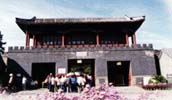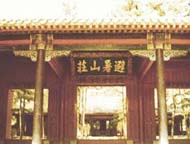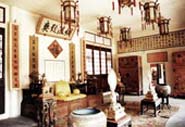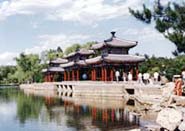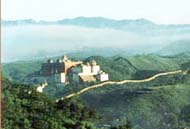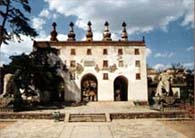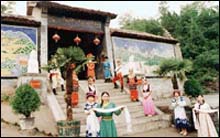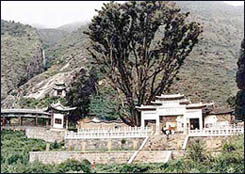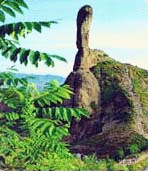Imperial Summer Resort Chengde
The Imperial Summer Resort was the largest imperial garden in the Qing Dynasty. It covers an area of 5.64 million square meters, is twice as big as the Summer Palace in Beijing. The imperial theme of "collecting the world scene in one garden, moving the best beauty to one place" is represented in the garden, which combines the grace of South China with the grandeur of North China. The construction of Imperial Summer Resort was started in 1703; |
|
after 89 years, until the year 1792, its 124 groups of constructions had been finished in which there were 72 scenic sites named by the Emperor at that time. The whole construction area is about 100 thousand square meters.
The Imperial Summer Resort can be divided into the palace zone, the lake zone, the mountain zone and the plain zone. In the south it is the palace zone consisting of formal Palace, Pine & Crane House, East Palace and Million Valleys and Pines, four groups of structures. The palace zone has become the Royal Art Museum and the place for recovering historic legacy of the palace of the Qing Dynasty. In this zone there are the gray tiles and the plain bricks with the winding old pines and the thick crown of trees, in which you'll have a chance to feel the real nature, grace and primitive simplicity.
The lake zone has an area of about 500mu, divided into many small lakes by the islands and dykes such as Chenghu (Clear Lake), Ruyihu (Happy Lake), Yinhu (Silver Lake) and Jinghu (Mirror Lake).
On the surface of the lakes you can see Qingliandao (Green Lotus Island), Ruyizhou (Happy Island), Yuese Jiangsheng (Island for Enjoying the Water Songs under the Moonligh) and Huanbi (Green surrounded Island) and other is lands. On the lakes the branches of weeping willows hang downwards, and there are small green ripples on the lakes, with lotus swinging in the gentle breeze. It is really like the graceful scene in South China.
The plain zone is located on the north of the lake zone covering an area of 53 hectares, which mainly include Wanshuyuan (Ten Thousand Trees Garden), Shimali (Place of Trying Horses), Yongyou Temple (Permanent Blessing Temple) and Sheli Pagoda and other tourist sites. In the Qing Dynasty the Emperors usually held the head meeting in Ten Thousand Trees Garden, had dinner with fireworks, lights, music and dancing and singing. The Big Army Tent and Mongolia Box were built when there were large-scale activities. Now the Mongolia Box is rebuilt into the Village for Holiday.
The mountain zone covers n area of 4.22 million square meters. The highest peak is 510 meters high above the sea level, and it is 180 meters higher than the plain zone. Emperor Kangxi and Qianlong had ordered to build more than 40 buildings, pavilions, temples, and houses which had small tourist imperial paths and narrow winding tracks towards the hills. The mountains are winding mountains with deep ditches, gullies and valleys in all directions, thick forest and clear mountain brooks, which form different landscapes in four seasons. Now you can get to the top of the hills by cableway and look from the mountain at the great wonders on four sides of the mountain; Yunshan (Cloud Sea), Beizhenshuangfeng (Twin Peaks Facing North) and Nanshanjixue (Snow on the South Mountain).
|
The Gate of the Imperial Summer Resort Chengde
It is the gate of the formal palace zone with a plate with the inscription "Imperial Summer Resort" written by Emperor Kangxi himself. So the name "Imperial Summer Resort" appeared.
Hall of Frugality and Placidity Chengde
|
The Hall of Frugality and Placidity was made of Nanmu (a kind of high-quality wood, hard and durable). It is the place where Emperor held grand celebrations and met the princes, dukes, ministers and foreign diplomatic envoys.
Sizhi Book House Chengde
The Sizhi Book House is the place where the Emperor met close ministers and took a rest.
Hall of Refreshing in Mists and Waves Chengde
The Hall of Refreshing in Mists and Waves is the bedchamber of Emperor in the Qing Dynasty.
Tower of Mists and Rains Chengde
The Tower of Mists and Rains was built following the example of the Tower of Mists and Rains on South Jiaxing Lake in Zhejiang Province. When it is raining in the mountains, there will be a lot of mists rising up like gauze which make you feel like flying in the paradise like a celestial being.
|
|
Golden Hill Chengde
|
The Golden Hill in Imperial Summer Resort was built following the example of Jinshan Temlple (Golden Hill Temple) of Zhenjiang in Jiangsu Province.
Shuixin Pavilion Chengde
The Mid-Lake Pavilion is located between Xia Lake and Silver Lade. When the gentle breeze blows, the lake water will undulate with wind shining the light
|
and you'll seem to be in the region of rivers and lakes in the south of Yangtze River.
Outer Eight Temples Chengde
On the east and north of Imperial Summer Resort there are twelve colorful, attractive, magnificent and glorious grand Lamaism temples that are encircled by waving mountains just as the moon was surrounded by plenty of stars. These temples are models of the Hans, Mongols, Tibetan temples. From them we can see and feel the grandness of Potala Palace in Tibet, the magnificence of Tashilhunbu Monastery, the elegance of Shuxiang Temple on Wutai Mountain, |
|
the beauty of Guerzha Temple of Yili in Xinjiang and the world wonder-the largest Bodhisattva made of wood in the world which has thousands of hands and thousands of eyes. At that time eight temples of them were managed by the government of the Qing Dynasty and registered in Beijing Lama Publishing and Registration Council.
There is also "Lama Office" in Beijing situated out of old north gate, therefore generally called "Outer Eight Temples" (means eight temples out of the gate entrance). Afterwards the name "Outer Eight Temples" refers to these twelve temples. In December 1994, Outer Eight Temples together with the Imperial Summer Resort were listed as the World Cultural Heritage.
Among the Outer Eight Temples, Temple of Universal Love (Puren Temple) and Temple of Universal Kindness (Pushan Temple) were built during the reign of Emperor Kangxi, the other ten temples were built during the reign of Emperor Qianlong, Emperors built so many temples in order to follow the customs of Mongolia and Tibet minorities believing Lamaism.
"Don't change its customs, just because of its religion", they controlled people by building deep feeling in the mass so as to reach the political goal of joining up all forces inside and outside the country and then achieve the consolidation of nations. It reflected the history of the Qing Dynasty that defeated the splitting forces inside the country, improved the nation unity and resisted the foreign invasion.
|
The Imperial Summer Resort is quite different from the Outer Eight Temples in the outside design. Either grand imperial palace or entertainment house, building, pavilion and tower are built with gray bricks and plain tiles which strikes you with a feeling of nature and simplicity, However Outer Eight Temples were built with attractive, fresh and beautiful color such as colored glaze tiles and gold-plating scale roof, they look really spectacular and marvelous. |
The construction styles of twelve temples are Han style, Tibet style and the combination of Han and Tibet. The building, the garden, the inscription, the sculpture, the mural, the sacrifice and other cultural relics are ancient treasure to study the history of the Qing Dynasty, culture, religion, art and to understand the wisdom of working people. Twelve temples have experienced hardships for more than two hundred years, seven of them are in good condition and open to public.
Saiwai Yefengzhai Chengde
Saiwai Yefengzhai (a natural northern-frontier scene) is located in Toudaogou, Chengde city, which is opposite to the biggest imperial palace-the Imperial Summer Resort. In the model village, there are different kinds of architectures such as Miao stockaded village, Mongolian box, thatched cottage and so on, from which you can feel different national characteristics. |
|
When you climb up to the "Sightseeing Pavilion", the Imperial Summer Resort, Outer Eight Temples and Qingchui Peak and other scenery spots are in front of you.
In Yefengzhai, tourists are able to watch acrobatic show from the famous area of Wuqiao and appreciate the performance of singing and dancing of Miao, Bai, Wa, Buyi, Mongolia minorities, to feel different traditional and amorous feelings from different nationalities.
Qingchui Peak National forest Park Chengde
Qingchui Peak National Forest Park covers a whole area of 1588.97 million hectares in which scenic spot covers 12. 7586 hectares and other 31311 hectares are protection zone. It includes Qingchui Peak, Sengguan Peak, Mountain Villa Temple, Jiguan Mountain and Jiaqianggou scenic spots. There are rich animal and plant resources and unique peaks and strange stones. There are 45 families, 83 genus and 142 species xylophytas and national and provincial protection wild animal, so it is a perfect place for visitors to travel, sightsee and spend holidays.
Shuangta Mountain Scenic Spot Chengde
|
Shuangta Mountain Scenic Spot lies in Shuangluan District, around 10 kilometers from the center of the city. The landscape of Mountain with Two Pagodas is composed of two cliff summits in the center of the scenic spot. Mountain with Two Pagodas is 488 meters high above the sea level, and the peak is about 40 meters high with a diameter of around 20 meters.On each top of the summits there is a structure like a pagoda. |
In the distance you can see clearly the arched door and tiers of bricks. It is always an enigma when it was built, why it was built, and how it was built. Nowadays, there is a ladder to get to the pagoda, so people can see closely the structure and bricks and then try to find out the answer to the riddle.
Mountain with Two Pagodas Scenic Spot is beautiful with brooks, forest and valleys. In 1993 it was approved to be a provincial forest park. In 1997 Mountain with Two Pagodas Scenic Spot was rebuilt by the Chengde government. The human scenic spot mainly includes Sanxian Guan (Taoist Temple), Qibao Tower, Lingfeng Old Courtyard, Cliff Stone Inscription and so on with the basic facilities of roads, bridges and parking lots.
Danxia Landform (Rosy Clouds Landform) Chengde
Around Chengde City there is a kind of peculiar landform. That is formed through long time geological process, which features red rocks named afterwards "Rosy Clouds Landform".
Rosy Clouds Landform in Chengde is rare in the north of China. Compared with rosy Clouds Hill (Danxia Hill) in the north of Guangdong Province, it seems to be not only more peculiar and handsome, but more vigorous and grand. Its main natural landscape includes Qingchui Peak, Hamo Stone (Toad Stone), |
|
Luohan (Arhat) Mountain, Sengguan Peak, Tianqiao Mountain, Mountain with Two Pagodas, Jiguan Peak and so on. It is told that Emperor Qianong had ever divided the perfect mountains and springs into ten landscape, moreover wrote poems to be eulogized everywhere:
The scenery in the Imperial Summer Resort is perfect, you can see the following scenery in the east of Fengmo Mountain. The Arhat Mountain is high enough to make everybody see it, Qingchui Peak is very large and tall. Toad Stone lies toward south, in front of Dehuimen is the hot spring. The Jiguan Peak can reach the moon, Buddha's mountain is winding contimously. Fairy is hid in the two pagodas towards the sun, in the cave of Yuanbao Hill the glossy ganoderma is growing. |
